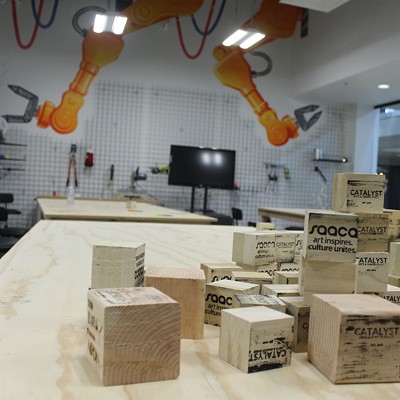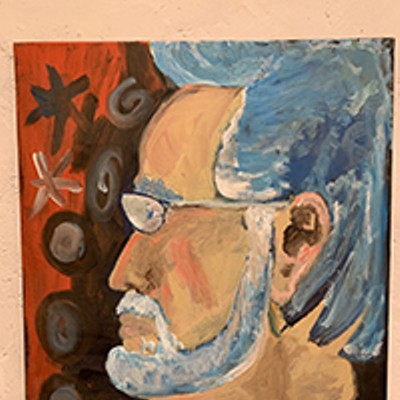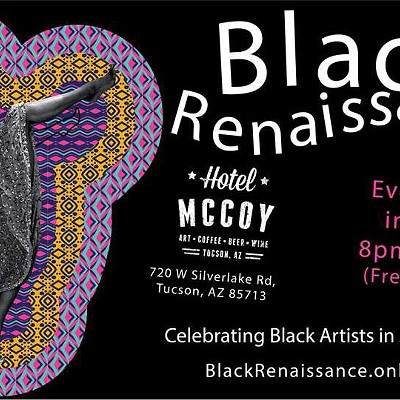This year is no different, except that 2005 is a number divisible by 401. With that in mind, from April 14 to April 24, The Screening Room and Crossroads theaters (and occasionally The Loft and several other locales) will be host to some of the best and least-commercial films available. That's what makes a film festival worth going to: the fact that most of these are films that are not only not going to be playing at The Man's multiplex; they are not going to be playing on cable or that weird UHF station that used to show Dr. Gene Scott.
According to Mr. Scalinger, "The sorry part of this business is that gems don't get seen. And when people do see them, they say they want to see more."
And that's why he runs the festival, so you can see these gems that no one will put big money behind.
I think the best thing about film festivals is the selection of short films, a form that has really suffered since cinemas stopped showing them before features. "What killed the short film in the United States is the music video," Scalinger told me, because that became the only short-film format that anyone was interested in seeing or buying.
The shorts that I enjoy most are often the animated ones, and this year, the Arizona festival is blessed to have the latest piece by Don Hertzfeldt, who's probably America's finest animation talent. (If you haven't seen his previous film Rejected, I would suggest that you have missed out on what could well be this generation's A Hard Day's Night.)
But even better is his The Meaning of Life, playing as part of the animated shorts program. Meaning of Life is like the movie Picasso would have made, if Picasso had actual talent. Or maybe it's like Fantasia, if Fantasia weren't for people on drugs, but for people who are drugs. In sum, this 12-minute film uses sophisticated stick figures to trace the history of life on Earth from simple protozoa to multi-headed space-monsters, just like it says in the Bible. (I mean the real Bible, the one the white man won't let you read.)
Also on the animation program is the incredibly beautiful Winter, an entirely hand-drawn piece that creates the illusion of optical zooms by using a new drawing for each frame. It's stunning, even if the story is a bit pointless. On the other end of the tech spectrum is the computer animated 9, a wordless film about numbered humanoids who are hunted in their miniature, post-apocalyptic landscape by a robot with a cat skull for a head and soul-sucking power in its eyes.
It looks a lot like a Jan Svankmajer film, only a little more computer-y.
There's also Fallen Art, an incredibly sick and inventive 5-minute animation about execution as an art form. I mean, not that executing people is the art, but that if you then take the executed bodies and ... well, you have to see it. 3-D animation at its most ... umm ... something.
Though not being shown as part of the animation program, one of the best animated films at this (or any) fest is The Egg by Benh Zeitlen. It can be found on the comedy shorts program. This is the kind of film that justifies the existence of film festivals. It features a stop-motion animated Ahab who sails the great, white albumen with his dead crew while desperately searching for the elusive yolk. Meanwhile, bird-like people eat from metal bowls that go by on a conveyer belt. One bowl contains ... the egg! This was shot on glorious 16mm film. I beg you to watch this before the Federal Communications Commission makes it illegal to see close-ups of uvulas.
I'm only partly kidding about the FCC. As our speech and expression rights become more and more restricted, these festivals really do serve a political purpose.
"They're my political activism," Scalinger said. "Some want to save the whales; I want to save the independent filmmaker, for freedom of expression reasons."
Which is why the festival has such a "strong political thread. Independent film is like the pulse of the nation, dealing with issues that Hollywood films don't deal with." There are, for example, two films in this year's festival dealing with the difficulties facing America's national guards when they are called for overseas duty. There's a dramatic short about female genital mutilation as it's currently being practiced in North America. And there are a number of documentaries on topics that are too touchy, or too outré, or just too rarified to be addressed by mainstream media.
Documentaries usually don't get much theatrical distribution (although this has been changing in recent years). Among the docs at this year's fest are A Second Final Rest: The History of San Francisco's Lost Cemeteries and Behind Enemy Lines.
The former is one of those films whose topic is so odd that it would have trouble finding a place even on cable. It tells the story of how San Francisco voted to eliminate its non-living population, until eventually there were no more burial grounds within the city limits. This produced towns like Colma, a modern-day necropolis which has 1,200 living residents and 2 million dead ones. It also resulted in the use of headstones as paving and foundation stones. Second Final Rest is full of bizarre and interesting factoids, though I found its reverential tone a bit off-putting as the film wore on.
Behind Enemy Lines, on the other hand, put me off at the start and then sucked me way in. The fact that it was yet another documentary about the Palestinian/Israeli conflict was a turn-off, but the form of this doc is incredibly effective, and you can't help but be won over by how human it is. It reunites Adnan, a Palestinian peace activist, and Benny, an Israeli policeman, three years after they had both been part of a peace delegation in Tokyo, and two years after the start of the second Intifada. The two go on a driving tour of sites that have been affected by the violence, and they alternate between moments of deep friendship and even deeper division. The dialogue between the two is breathtaking: pointing out a Jewish settlement that was taken from Palestinians, Benny says, "Do you know what this place means to the Israelis? Did you know that it is in the Bible?" to which Adnan replies, "Everything to you has to do with your Bible." Talking about the flood of suicide bombers, Adnan makes a painfully unselfconscious understatement when he says, "It got out of control." Behind Enemy Lines shows how essentially peaceful people can begin to justify violence once the blood-dimmed tide is loosed, and produces a disturbing and effective image of what happens when the best lack all conviction, and the worst are full of passionate intensity.
Two less political, and more personal documentaries that I had a chance to view were both effective and inventive in their visual styles. Small Town Secrets is partially filmed off webcams during teleconferences between director Katherine Leggett and her father. Leggett had an odd childhood, in that her parents divorced, and her mother took the kids to live in a duplex with her lesbian lover. Meanwhile, her father had moved in with his male lover. Then Katherine started to have relationships with women. And none of them told any of the others that they were gay. It's a sort of "the family that stays in the closet together" tale, told through the marvel of the Internet age.
A similarly personal "family documentary," though completely different in tone and topic, is '87 Topaz. While I think almost all the films you see at the festival have some flaw (which is part of what makes the festival great: You get to see things that lack the high-buff polish of a Hollywood release), '87 Topaz seems just about perfect in its 7 1/2 minutes. Director Bill Kersey takes his grandfather's diaries and distills them into weirdly chilling little bits that show how automobiles had a meaning on par with work, family and religion for a certain segment of mid-20th-century America.
On a much lighter note, there are dozens of comedic shorts that are worth checking out. 8 Minutes to Love is notable for the appearance of Sandra Oh as a woman on a "speed date" who encounters her skeevy ex-boyfriend during a game of rotating losers. Brian Belefant's 19-minute Burning Passion is about a man whose super power is flaming spunk. It goes way too far, and in a good way, so stick with it to the great nun-sex funeral scene. And there's Samuel DeMango, the tale of a man who eats nothing but mangos, thus turning himself into an unkillable mango-man who wants only to be loved, which is hard, because he's all mango-ey. It doesn't really work as intended, but it's laudable in its weirdness.
Probably the funniest of the short comedic pieces that I saw was Broadcast 23. It's essentially a single-joke film, but it's only a few minutes long, so that's just about right. It's hard to talk about it without giving away the joke, but let's just say that there's something about bigfoots that you don't want to know.
One of the weirdest of the comedic shorts is Turntable Trauma. It's an odd combination of mockumentary and documentary, featuring a grammatically incorrect voiceover narration by a man trying desperately to sound authoritative while at the same time tripping and stumbling over his words. It's so weird that I wasn't sure if it was the work of genius or idiocy, and it does go on a little too long, but still, it's probably worth checking out, just because it'll make you go "huh?" As an added bonus, it's shot on 16mm, the vanishing and beautiful format that is being supplanted by the cheaper, but less-attractive, digital video.
Less weird, but more consistently effective, is Manual de Amore (Love Manual), which looks at the various ways people find pleasure on this whirling ball of dirt we call "the Earth." Like, one woman has sex with her car. A hairy man puts on a bra and lipstick. A lonely man looks out the window while lowering his drawers. And a woman of a certain age finds a new use for her electric toothbrush. Strangely, this doesn't come off as creepy, but rather touching and funny. Plus, of course, there's an explosive ending.
One of the shorts that I thought was not particularly succesful might be worth seeing, just because it includes one of the four greatest actors who ever lived. No, not Ron Palillo. No, not Robert Hegyes. No, not John Travolta. Yes, that leaves only Lawrence Hilton-Jacobs, who, if he were to win the Nobel Prize in medicine for curing death, would nonetheless be introduced as "the man who played Freddy "Boom Boom" Washington." He stars in Don't Give Me the Finger, which is yet another variant on the famed Twilight Zone episode where a man bets a car for a finger that he can light his pocket lighter 10 times in a row. The schtick has been done to death, but nothing's really been done 'til it's been done by a Sweathog.
Mr. Jacobs is one of the few stars you'll see on screen at the fest, and there will be even fewer in attendance. This, I think, is what makes the Arizona Festival so much better than, say, Sundance.
"My stars are the indie filmmakers," Giulio Scalinger told me. "(A few years ago), we had Edward James Olmos at the Festival, and it was fun, but a headache: limousines and bodyguards. That's the complaint about Sundance."
And it's a valid one. When an independent film festival focuses on celebrities, it loses its raison d'etre and turns into a little more than a market place. "We want to support indie film and filmmakers, offer the opportunity to show their films and interact with the community. That's why we have the Festival in the Schools, where they go into a school and talk to kids, and that might create four or five new audience members who'll appreciate indie film."
Avoiding the stars also gives more opportunity for up-and-coming talent, and for films that refuse to be commercial, whether in content or format.
The medium-length film is one such format, and an excellent one for starting filmmakers. In fact, I wish more Hollywood movies would accept that they have only 35 minutes of plot, and not pad things out with an additional hour of Jimmy Fallon trying to be "funny."
Among the medium-length films at this year's festival, The Prince of Jersey shows real promise on the part of director Alexander Maslow. He gets great performances out of his two male leads in a predictable, but nonetheless compelling story of small-town losers. The plot may be standard, but the particulars of the script and acting create an effective and uncomfortable naturalness that indicate a strong future for Maslow.
An overly standard story is not a flaw of Summer of the Serpent, by Kimi Takesue. This film would be flawless if it were just a little shorter. Nonetheless, it's effectively weird enough to be well worth watching. A young girl at a community pool is entranced by the apearance of a beautiful, elegantly dressed Japanese woman and her overly formal servant/bodyguard. The two are uncannily out-of-place at the publicly accesible pool, and director Takesue is smart enough to not offer an explanation. Instead, she just revels in the oddness of the juxtaposition. This is one of the great benefits of a film fest: whereas a mainstream movie is obliged to clear up any ambiguities, an experimental director can allow them to have their fullest effect by leaving them as mysterious.
Winter Sea is more conventional in its narrative style, but touches on a subject that is not well handled outside of truly independent cinema. It's a non-didactic look at an incestuous relationship. Ellen loves Paul, but he's her brother, so she gets it on with Gabriel, but he's her boss, and an ugly old man to boot. Further, there's something not quite kosher about Ellen's relation with her drunken mother. In spite of its politically incorrect subject (the incest is never condemned nor seen as coercive), the actors make this seem both natural and, in some way, acceptable, which means this is not the sort of thing you'll be seeing on the ABC Movie of the Week.
Of course, even at an indie fest, the feature-length films tend to get the most attention. One of the biggest events at this year's festival is the Arizona premiere of How The Garcia Girls Spent Their Summer, by University of Arizona alum Georgina Riedel. I haven't seen it, but it received strong reviews at Sundance.
I did get a sneak peek at After the Apocalypse, director Yasuaki Nakajima's first film. It's an incredibly bleak story of five survivors of World War III, but what sets it apart is the lack of dialogue. Nakajima does an incredible job of producing a clear narrative without resorting to a single line of exposition. Since science fiction is pretty much the exposition genre, that's quite a feat. After the Apocalypse is, not surprisingly, tremendously bleak, and probably not everyone's cup of tea, but as an experiment in what can be done in silent film, it's tremendously impressive.
Even more experimental was Trains of Winnipeg--14 Film Poems, by Clive Holden, a series of 14 short films, many of them recitations of poems over stunning imagery. Holden is a master of the captivating visual, and a surprisingly good poet, though he really should have gotten someone else to read the poems, as his voice is increasingly unpleasant. Nonetheless, if you focus on sight and not sound, this is the kind of film that is so appealing it could, if given the chance, really expand the audience for non-narrative film.
I also watched the appalling first feature film by Tucson Weekly film critic James DiGiovanna and underground filmmaker Carey Burtt, A Forked World, about a depraved, anti-hipster couple. Angela uses homemade dolls to taunt strangers. Barry eats meat and plays the bass, only because those are the worst things he can think to do. Their hate-based love is challenged when Barry discovers the New Age philosophy of Spoon Consciousness, and Angela starts sleeping with a deranged priest. If you think dark comedies about emotional torture are "funny," then you're probably the kind of philistine who'd enjoy this.
Oh, wait a minute. I am Tucson Weekly Film Critic James DiGiovanna. Nevermind. This film is excellent.
Of course, it's not just the films that make a film festival great: there are also loads of awesome events. Check out www.azmac.org for the evolving schedule, which will include a daily breakfast with various film folk, including one with Shelli Hall, of the Tucson Film Office, who's not only shockingly smart and helpful; she's also instrumental in bringing film production to Tucson. There's also the "Mid Week Bash" at the Hotel Congress, featuring music by Al Perry and kibitzing with the festival folk. There's the Film in the Schools program. There are seminars. There's a nightly music café. There are awards to be given, and a closing party that is rumored to include much in the way of cinematic debauchery.
And, of course, there's your chance to meet actual filmmakers and discover that they're people just like you who can give you tips on how you can make something to enter into the next festival.










